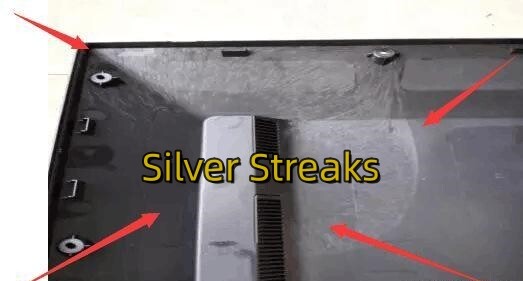Erreur de format d'e-mail
emailCannotEmpty
emailDoesExist
pwdLetterLimtTip
inconsistentPwd
resetAccountPassword
forTheAccount
pwdLetterLimtTip
inconsistentPwd
resetSuccess
resetSuccessTips
login

Offer Technical Support and Customized Solutions
The company is committed to creating new and improved plastic materials to meet the evolving demands of the market.

Silver Streaks: Understanding Surface Defects in Injection Molded Parts
2023-12-21 11:41:52
Introduction:
Silver streaks, long and needle-like silver-white frosty lines on the surface of injection-molded parts, occur when the mold is not completely filled, resulting in a rough front end and the formation of streaks. These streaks can be caused by the interference of gas during the molding process, leading to the appearance of silver streaks or small bubbles on the surface of the product or bubbles forming inside thick-walled products. The main sources of these gases are moisture or volatile substances in the raw materials or excessive lubricants. Additionally, high material temperatures or prolonged heating can cause material degradation and the generation of degradation gases.
More solutions during injection molding process:
Short shot:
https://www.toponew.com/blog/how-to-deal-with-underfilled-or-short-shot-in-injection-molding
Flash:
https://www.toponew.com/blog/resolving-flash-and-burrs-in-engineering-modified-plastic-injection-molding
Bubbles:
https://www.toponew.com/blog/analysis-and-solutions-for-bubbles-and-vacuum-bubbles-in-plastic-products
Sink mark:
https://www.toponew.com/blog/troubleshooting-sink-marks-in-injection-molded-products
Warp:
https://www.toponew.com/blog/injection-molding-blog--understanding-and-addressing-warping-defects
Crack:
https://www.toponew.com/blog/troubleshooting-cracking-and-whitening-issues-in-injection-molding-processplxzp
Silver streaks, long and needle-like silver-white frosty lines on the surface of injection-molded parts, occur when the mold is not completely filled, resulting in a rough front end and the formation of streaks. These streaks can be caused by the interference of gas during the molding process, leading to the appearance of silver streaks or small bubbles on the surface of the product or bubbles forming inside thick-walled products. The main sources of these gases are moisture or volatile substances in the raw materials or excessive lubricants. Additionally, high material temperatures or prolonged heating can cause material degradation and the generation of degradation gases.
Causes of silver streaks in injection-molded parts:
- Raw Materials
- Contamination or excessive dust in the raw materials can lead to thermal decomposition.
- Excessive use of sprue material (regrind) or high proportions of sprue material (generally should be below 20%).
- Additives in the materials decompose, resulting in silver streaks.
- Excessive moisture in the materials that haven't been adequately dried, causing silver streaks in the parts.
- Mold
- Defects in mold design, such as poor gate placement, small gate size, asymmetrical gate layout for multi-gated parts, narrow runners, or inadequate cooling system, can create significant temperature differences in the mold, causing discontinuous flow of the melt in the cavity and blocking air channels, resulting in silver streaks.
- Sharp corners in the mold create excessive shear when the melt flows through, causing silver streaks.
- Insufficient or poorly positioned venting channels on the mold parting surface, without the presence of inserts or ejector pins for venting, prevent proper air evacuation from the mold cavity, leading to silver streaks in the parts.
- Rough mold surface with high friction resistance causes localized high temperatures in the mold, leading to plastic decomposition as it passes through, resulting in silver streaks on the part surface.
- Mold leakage of oil, water, or air causes silver streaks on the part surface.
- Equipment
- Small nozzle or material drooling or stringing at the nozzle, obstruction in the barrel or nozzle, and high-speed material flow causing frictional heat that leads to material decomposition.
- Barrel or screw wear, excessive retention of molten material, or dead spots in the flow, leading to long-term heating and decomposition.
- Uncontrolled heating system causing excessively high temperatures and plastic decomposition.
- Improper screw design that allows air entrapment.
- Process
- Excessively high material temperature causing decomposition.
- Excessively high barrel temperature or heating imbalance; gradual reduction of barrel temperature should be considered.
- High temperature in the feeding section, causing premature melting and filling of the screw channel, preventing air from escaping through the feed opening.
- Excessive injection speed subjecting the molten plastic to high shear forces and causing decomposition, resulting in gas formation.
- Insufficient injection speed causing inadequate filling of the mold cavity and low surface density of the product, leading to silver streaks.
- Insufficient material volume, excessive buffer padding, low material temperature, or low mold temperature affecting melt flow and forming pressure, leading to the formation of bubbles.
- Inadequate screw preplasticizing back pressure or excessive screw speed causing rapid screw retreat and easy air entrainment along with the material to the front end of the barrel.
Injection Molding Silver Streak Solution:
- Material
- Pre-dry the raw material before injection.
- Choose materials with higher stability.
- Control the proportion of runner material to be less than 20%.
- Avoid impurities entering the raw material.
- Mold Design
- Increase the size of the main runner, sub-runner, and gate.
- Design sufficient venting positions.
- Avoid sharp corners in the mold and ensure a smooth surface.
- Regularly maintain the mold to prevent oil or water leakage.
- Molding Process
- Select an appropriate injection molding machine.
- Use a suitable screw.
- Increase the back pressure of the injection molding machine.
- Adjust the relevant parameters to the optimal range.
- Improve the venting system.
On-Site Investigation Guidelines:
- Material Inspection
- Feeding Process Inspection
- Dryer Equipment Inspection
- Nozzle Heating Ring and Barrel Temperature Inspection
- Inspection of Key Conditions affecting Silver Streaks in the Injection Molding Process
- Mold Inspection
More solutions during injection molding process:
Short shot:
https://www.toponew.com/blog/how-to-deal-with-underfilled-or-short-shot-in-injection-molding
Flash:
https://www.toponew.com/blog/resolving-flash-and-burrs-in-engineering-modified-plastic-injection-molding
Bubbles:
https://www.toponew.com/blog/analysis-and-solutions-for-bubbles-and-vacuum-bubbles-in-plastic-products
Sink mark:
https://www.toponew.com/blog/troubleshooting-sink-marks-in-injection-molded-products
Warp:
https://www.toponew.com/blog/injection-molding-blog--understanding-and-addressing-warping-defects
Crack:
https://www.toponew.com/blog/troubleshooting-cracking-and-whitening-issues-in-injection-molding-processplxzp
Nous contacter
ÉTIQUETTES DE PRODUIT

